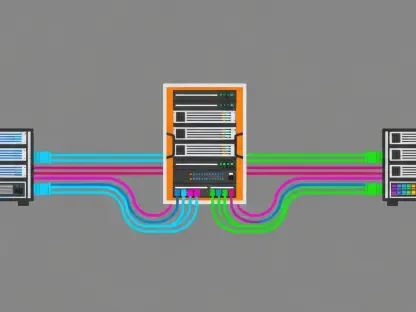Artificial intelligence (AI) is revolutionizing the landscape of cyber threats, making cybercrime more efficient, harder to detect, and significantly more damaging. This article explores the evolution, characteristics, types, impacts, and defense mechanisms surrounding AI-driven cyberattacks, shedding light on the complexities and innovations in modern cybersecurity.
Evolution of Cyber Threats
From Manual to Automated Attacks
Historically, cyberattacks involved manual methods such as phishing, SQL injections, and malware, which were labor-intensive and required direct human input. These traditional methods presented predictable patterns that could be countered with standard security measures like firewalls and antivirus software. However, the integration of AI into cyberattacks has completely altered this scenario. Hackers now have the capability to automate and streamline various aspects of their attacks, making them more sophisticated and less dependent on human intervention. This transition has exposed the limitations of traditional security methods, ushering in a new era of advanced threats that are more difficult to anticipate and counter.
The Rise of AI in Cybercrime
Unlike traditional methods, AI automates and expedites attacks, making them faster, smarter, and significantly less human-dependent. A Darktrace survey highlighted that around 74% of IT security professionals have noted a substantial increase in AI-powered threats, signaling the heightened risks associated with AI-enhanced cybercriminal activities. This rise of AI in cybercrime is not only a challenge for security professionals but also a call to action for the entire cybersecurity industry to innovate and upgrade their defenses. The advent of AI in cyberattacks marks a shift in the threat landscape, requiring a corresponding evolution in defensive technologies and strategies to keep pace with these rapid advancements.
Characteristics of AI-Powered Cyberattacks
Automation and Data Analysis
AI automates various tasks within a cyberattack, such as vulnerability scanning and malware deployment, significantly accelerating the attack process. Hackers leverage AI to analyze patterns, user behavior, and security gaps to launch highly informed attacks. This level of automation enables attackers to execute multiple attacks simultaneously and adapt their strategies in real-time, making it increasingly difficult for traditional defense mechanisms to keep up. Moreover, AI’s ability to process vast amounts of data allows cybercriminals to uncover insights and launch precision-targeted attacks that are more likely to succeed, significantly elevating the threat level posed by such activities.
Adaptability and Precision Targeting
AI-driven attacks dynamically adjust in real-time to circumvent security defenses. By reducing manual effort, AI enables the rapid scaling of cyberattacks. AI enhances the personalization of attacks, making phishing scams, deepfakes, and other tactics more convincing and difficult to detect. Cyber attackers can continually refine and modify their attack vectors based on the feedback from their initial attempts, maintaining the element of surprise and amplifying the challenge for security teams. This capability not only amplifies the sheer volume of attacks but also increases their efficacy, as each subsequent attack becomes increasingly sophisticated and harder to defend against.
Common Types of AI Attacks
AI-Driven Phishing and Adversarial Attacks
AI crafts realistic and personalized phishing emails to deceive recipients. It can scrape social media and other public sources to tailor these messages, evade spam filters by modifying wording and formatting continuously, and initiate deepfake-driven voice and video phishing to trick victims effectively. Adversarial attacks specifically target AI models by manipulating input data to cause misclassification, exposing weaknesses to generate harmful content, or corrupting AI decision-making by poisoning training sets with malicious data. These adversarial tactics exploit the very foundations of AI systems, creating a feedback loop where AI is used both as a tool and as a target in cyber warfare.
Weaponized AI Models and Data Privacy Attacks
Cybercriminals develop AI models designed explicitly to facilitate hacking, such as bots that scan for software vulnerabilities, self-evolving malware that alters itself in real-time to avoid detection, and deepfake models that mimic executives or bypass biometric security. AI’s capacity to handle large volumes of personal data makes it a prime target for exploitation. Techniques such as model inversion, where attackers reconstruct data from an AI model’s memory, and membership inference, which determines whether specific data was used in training, pose significant risks. Side-channel attacks, which extract hidden information by analyzing system response times, further compound the threats to data privacy, exploiting even the minutest system interactions.
Real-World Examples of AI in Cybersecurity
DeepSeek Cyberattack and Deepfake Scams
In 2025, AI chatbot DeepSeek was compromised by hackers who manipulated its responses to spread misinformation and extract sensitive data, reflecting vulnerabilities in AI chatbots. Fraudsters used AI to create deepfake audio mimicking a company executive, convincing an employee to transfer $25 million into fraudulent accounts, showcasing AI’s potential in near-perfect voice mimicry. These real-world instances underscore the potential damage AI-enhanced cyberattacks can inflict, highlighting the need for robust measures to safeguard against such sophisticated threats that go beyond traditional cybersecurity paradigms.
T-Mobile Data Breach and SugarGh0st RAT Phishing Campaign
AI-driven methods enabled hackers to steal data from 37 million customers, effectively evading traditional detection systems and extending the duration of the attack. A Chinese-backed group deployed AI-enhanced phishing emails targeting U.S. AI researchers to extract advanced machine learning models information. These breaches demonstrate the scale and stealth that AI can bring to cyberattacks, making them not only more pervasive but also significantly harder to trace and mitigate. The deployment of AI in these breaches highlights the escalating arms race between cyber adversaries and security professionals, necessitating continuous innovation in defensive technologies.
AI-Driven Ransomware and Automated Attacks
Evolution of Ransomware
Ransomware, which encrypts victims’ systems demanding ransom, has evolved significantly with AI integration. An attack on Synnovis disrupted NHS England services and patient data security owing to AI-assisted encryption avoiding detection. This evolution showcases how AI can enhance traditional attack methods, making them more efficient and harder to counter, thereby increasing the potential damage and urgency of such threats. The integration of AI into ransomware attacks signifies a turning point in cybercrime, raising the stakes for organizations to develop advanced defenses that can keep up with the accelerating pace of these threats.
Automated Attack Scaling
Groups like FunkSec utilize AI to make ransomware more scalable and automated, facilitating even low-skilled hackers to deploy sophisticated ransomware. This automation accelerates the deployment of widespread and efficient cyberattacks, necessitating a reevaluation of security strategies. The scalability and efficiency provided by AI lower the entry barriers for cybercriminals, democratizing access to powerful tools that were previously reserved for highly skilled hackers. This shift calls for an urgent and coordinated response from the cybersecurity community, emphasizing proactive defense measures and continuous adaptation to thwart these rapidly evolving threats.
How AI is Used in Defensive Cybersecurity
Enhancing Early Threat Detection
AI is a dual-edged sword in cybersecurity, serving both attacking and defending purposes. On the defense side, AI enhances early threat detection by analyzing unusual patterns, enabling real-time blocking of attacks. By leveraging machine learning algorithms, security systems can detect anomalies that traditional methods might miss, providing an essential boost to preemptive defenses. This proactive approach is crucial in a landscape where cyber threats are becoming increasingly sophisticated and pervasive, underscoring the importance of integrating AI into cybersecurity frameworks to maintain a robust and adaptive defense posture.
Identifying Zero-Day Exploits
AI efficiently identifies zero-day exploits, aiding rapid vulnerability patching. Artificial Neural Networks (ANNs) learn from past attacks and adapt, making them valuable in contemporary cybersecurity. By continuously updating their knowledge base and refining their detection capabilities, ANNs can provide timely and accurate identification of new threats, significantly reducing the window of opportunity for attackers. This rapid response capability is critical in mitigating the impact of zero-day exploits, which are particularly dangerous due to their novelty and the lack of existing defenses against them, reinforcing the need for cutting-edge AI solutions in cybersecurity strategies.
Ethical and Regulatory Challenges of AI in Cybersecurity
Bias and Ethical Concerns
AI intensifies cyber threats and introduces deepfakes, AI-powered phishing, and automated hacking. The bias within AI systems aggravates these issues, undermining threat detection. This bias can stem from various sources, including biased training data and flawed algorithmic design, leading to disproportionate impacts on certain groups and potentially exacerbating existing inequalities. Addressing these ethical concerns is essential to ensure that AI systems are reliable, fair, and capable of providing comprehensive cybersecurity solutions without compromising ethical standards and social responsibility.
Regulatory Measures
Regulatory measures like the EU’s AI Act and the U.S. AI Executive Order outline ethical AI standards, yet effective enforcement is crucial. Companies need to adhere to these standards to safeguard critical infrastructure and enhance cybersecurity resilience. These regulations aim to create a balanced framework that promotes innovation while ensuring that AI technologies are developed and deployed responsibly. Effective compliance and enforcement are vital components of this regulatory landscape, providing the necessary oversight to mitigate risks and encourage best practices in the ever-evolving field of AI-enhanced cybersecurity.
Impact of AI-Generated Attacks
Increased Risks for Businesses and Consumers
AI-enabled attacks significantly amplify data breaches, fraud, and financial losses. Businesses face heightened risks as AI facilitates more sophisticated and pervasive cyberattacks that traditional defenses struggle to counter. For consumers, the threat extends beyond financial implications, impacting privacy and personal security. This increase in attack sophistication demands a reevaluation of current security measures and a shift towards more advanced and adaptive cybersecurity solutions. The continuous evolution of AI-driven threats poses a formidable challenge, necessitating ongoing vigilance and proactive strategies to mitigate potential damages.
Advanced Cyber Threats
AI allows hackers to create more complex and sophisticated attacks that are harder to counter. This rapid advancement outpaces the capabilities of traditional security teams, requiring significant investment in training and technology to maintain an effective defense. The ability of AI to evolve and adapt in real-time makes it a powerful tool for cyber adversaries, emphasizing the need for continuous innovation in defensive strategies. The cybersecurity landscape must evolve in tandem with these emerging threats, leveraging AI’s defensive potential to address the growing complexity of AI-generated attacks and ensure robust protection.
Strategies to Mitigate AI Cybersecurity Threats
AI-Powered Threat Detection and Regular AI Model Audits
While AI-driven threats cannot be wholly eradicated, organizations can implement various measures to mitigate these risks. One key strategy involves using AI tools to analyze real-time activities, identify abnormal behavior, and block threats preemptively. Machine learning adapts to new attack techniques effectively. Conducting frequent audits of AI models is also crucial to identify vulnerabilities and prevent exploitation. By continuously monitoring and updating AI systems, organizations can stay ahead of cybercriminal tactics and enhance their overall security posture.
Stronger Authentication and Cybersecurity Awareness Training
Implementing multi-factor authentication (MFA) and biometric verification is essential to strengthen security measures and protect against unauthorized access. Additionally, cybersecurity awareness training for employees and users is vital in recognizing deepfakes, phishing attempts, and other AI-generated fraud schemes. Educating individuals about the latest threat vectors and best practices can significantly reduce the risk of successful cyberattacks. Collaboration between AI developers and cybersecurity professionals is also essential to fortify systems, predict AI-driven attacks, and ensure comprehensive protection against evolving cyber threats.
Closing Thoughts on AI in Cybersecurity
Artificial intelligence (AI) is fundamentally transforming the realm of cyber threats, making cybercrime more efficient, difficult to detect, and markedly more destructive. The evolving use of AI in cyberattacks is creating a dynamic and often precarious cybersecurity landscape. This burgeoning trend has introduced new, more sophisticated forms of cyberattacks that challenge traditional security measures and compound the difficulty of defending against various threats.
This article delves into the progression and characteristics of AI-driven cyber threats, examining their different types and the significant impacts they can have on individuals, businesses, and governments. AI’s ability to automate and refine cyberattacks makes them not only faster but also more adept at evading detection, resulting in increased risks and potential damages.
Furthermore, the discussion includes an exploration of innovative defense mechanisms being developed to combat these advanced threats. By understanding the complexities and advancements within modern cybersecurity, stakeholders can better prepare and respond to the evolving challenges posed by AI-driven cyberattacks. This insight is crucial for enhancing our overall cyber defense strategies and staying ahead of potential future threats.









